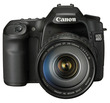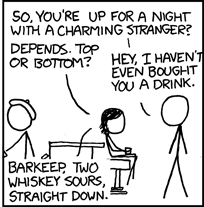Wednesday, November 12. 2008
Wo das Netz dünner wird, II

Bevor der Eindruck entsteht, aon sei eine gute Wahl, muss ich leider feststellen, dass abseits der Ballungsräume tatsächlich noch kein aonTV möglich ist, weshalb das ADSL nur mit max. 2MBit/s herumstreamt. Überdies bin ich dzt. nur auf 1MBit geschalten, was sich angeblich nach einiger Zeit auf 2MBit raufdreht. So hat es mir zumindest der Techniker bei der Installation erklärt. Seltsam allerdings, dass die verwerflichen Vertriebler von der Hotline damals gemeint hätten, es seien sogar 16Mbit möglich. Aber ist eh egal, ich nutze das Netz nicht (mehr) so exzessiv, und das Web geht mir mittlerweile ohnehin auf die Nerven und besteht zu 90% aus Zeitverschwendung; ein Rant sollte wohl bald folgen.
Immerhin war wegen der aktuellen Aktion die Herstellung gratis, und ich zahle dauerhaft nur €19,90 im Monat. Gemessen an den 16MBit für €35 (lt. UPC) dürfte ich ja eigentlich nur €2,20 im Monat für 1MBit zahlen. Subtrahiere ich die Telefonie-Grundgebühr jedoch, komme ich ohnehin etwa auf diesen Betrag, also was soll’s. Im übrigen wird wohl auch die Konkurrenz denselben technischen Beschränkungen unterliegen.
Saturday, October 4. 2008
Ökostrom vs. Naturstrom

Für unsere neue Unterkunft hab ich überlegt, ob wir nicht auf einen ökologischen Stromanbieter setzen wollen, um Kernkraft, Großwasserkraftwerken und der übermäßigen CO2-Produktion kalorischer Kraftwerke eine Abfuhr zu erteilen und gezielt erneuerbare Energien zu fördern.
„Ökostrom vs. Naturstrom“? Was soll denn diese gekünstelte Polarisierung? Nun, eine kurze Recherche offenbart zwar, dass Naturstromprodukte von den ehemaligen Strommonopolisten im Endeffekt nur Halbwahrheiten sind, da das Geld ja ohnehin unabhängig vom gewählten Produkt an den Großanbieter fließt, der damit macht, was ihm passt, u.a. eben auch die Investition in nicht-ökologische Stromproduktion. Aber mit dem Titel dieses Artikels will ich etwas anderes aufzeigen, nämlich die Konkurrenz zwischen den (dediziert) ökologischen Stromanbietern.
In Österreich gibt es zwei davon: Die Oekostrom AG und die AAE Naturstrom Vertrieb GmbH. Beide haben das „Österreichische Umweltzeichen“ für mindestens eines ihrer Produkte erhalten. Gute Frage also, wer von den beiden der optimale wäre. In Wikipedia und an anderen Stellen im Web ist die Rede davon, dass AAE von Greenpeace, GLOBAL 2000 und dem WWF empfohlen sei. Die Aussagen werden aber offenbar immer von derselben Person getätigt, was aus dem Namen bzw. den Initialen hervorgeht, und offensichtlich betreibt diese Person auch eine Photovoltaikanlage in Oberösterreich, die – no na – die AAE beliefert. Und Quellen für diese Aussagen habe ich auch keine gefunden. Klar, unter den Referenzen der AAE sind so klingende Namen wie Greenpeace, Die Umweltberatung, Die Grünen oder Sonnentor, aber GLOBAL 2000 und WWF tauchen nun mal in den Referenzen der Oekostrom AG auf. Und keine der bekannten Umweltorganisationen erwähnt bevorzugt nur einen der Anbieter, sondern stets beide gleichberechtigt.
Continue reading "Ökostrom vs. Naturstrom"
Sunday, September 14. 2008
RottenSupermarket.com

 In Anspielung auf RottenNeighbor.com. Allerdings gibt’s die im Titel genannte Domain noch garnicht. Sollte wohl geändert werden. Das Bild habe ich jedenfalls nicht irgendwo im Ostblock aufgenommen oder in den USA, sondern in Wien.
In Anspielung auf RottenNeighbor.com. Allerdings gibt’s die im Titel genannte Domain noch garnicht. Sollte wohl geändert werden. Das Bild habe ich jedenfalls nicht irgendwo im Ostblock aufgenommen oder in den USA, sondern in Wien. Friday, September 12. 2008
Finding dark places in Austria

Recently I took my first star trail images with my DSLR. There finally was no moon and clear sky, so I took my photo backpack and my tripod with me and drove at 2.00am a few kilometers outside the small town where we were staying that weekend. It was located in the Waldviertel (“Woodquarter”), a rather sparsely populated region at the north of Austria, and so I expected best conditions for taking pictures of a starry night. Indeed, the Milky Way was clearly visible. I pointed my camera northwards to capture the sky rotation, and although it was really dark, I was a little surprised that the trees silhouetted against the sky. And a long time exposure unveiled a faint orange glow at the horizon, although the next populated spot in that direction was a small village a few kilometers away.
This finally raised the question to me: How should I find the sparsest populated place within a certain radius? What data would I need to find that out? A set of coordinates of towns plus their number of inhabitants? Use that to compute an image and blur it? Or rather, is it possible to use data collected in the course of the light pollution issue?
By some research I was finally able to find
- the darkest place near the Waldviertel and
- the darkest place in Austria.
Continue reading "Finding dark places in Austria"
Wednesday, September 10. 2008
Nur für Physiker lustig

Tuesday, August 26. 2008
Canon EOS 50D announced

I was really surprised when I read that Canon itself leaked a webpage describing an EOS 50D! The surprise was due to the usual timespan of 1½ years after which Canon presented a successor of their respective EOS line. As the EOS 40D was presented in fall 2007, I didn’t expect a 50D to come before spring 2009. But probably the 50D came a little earlier to be placed against Nikon’s D300 that really outperforms the 40D.
Having a brief look at the specs I have the impression that it’s rather a minor advance compared to the 40D, fortifying the impression of a pure marketing decision rather than a real technology jump. The significant changes in my eyes are
- 15 MP compared to 10 MP,
- DIGIC IV processor compared to DIGIC III, and
- ISO 12800 max. compared to ISO 3200.
In the end only the last one in that list could be of interest if it implies a lower noise behavior at the same ISO speed. The jump from 30D to 40D was much more significant in my eyes, while that from 20D to 30D was only a cosmetic one in a similar way. However, as there obviously won’t be another successor in spring 2009, I can now be sure that my EOS 40D will stay a top camera for at least another year.
Much more interesting in my eyes is the upcoming EOS 5D
Monday, August 25. 2008
Binary archives in newsgroups

The usenet originally only consisted of text messages, but it soon became a way of exchanging binary files as well. As posts are usually restricted to only a few MB, larger archives have to be split up into several parts, each attached to its own newsgroup posting. But if some parts of these posts aren’t transferred correctly to other usenet hosts, the archive parts are broken.
Not necessarily if the poster created PAR2 archives in addition to the actual data archive parts. In a RAID-like manner, parity information is placed redundantly into the additional files. Thus, it is possible to recover the complete archive if some parts of it are incomplete.
As I downloaded some image archives (No, they were not p’rn) containing pictures in the PCD format that encapsulates six different resolutions of an image, I also had to find out how to explicitly extract the large (3072×2048) resolution out of it. All in all, I created the following (simple) script that
- checks the PAR2 files, and if some of the data archive parts are incomplete, it
- tries to recover them, and
- if check (or recovery) were successful, the PCD images are extracted and converted to JPEG.
I did it this way:
- #!/bin/bash
- # Verify, includes *PAR2 automatically
- par2 v *par2
- ret=$?
- if [ $ret -eq 0 ]; then
- # Extract
- unrar x *part01.rar
- cd “$(find -type d | tail -n 1)”
- # Convert
- for file in *PCD; do
- echo -n “$file ”
- convert $file[5] $(basename $file .PCD).jpg && rm $file
- done
- echo Done.
- elif [ $ret -eq 1 ]; then
- echo “PARITY CHECK FAILED, TRYING TO REPAIR.”
- sleep 2
- # Repair, if needed
- par2 r *par2 && echo “You may now rerun this script.”
- else
- echo “REPAIR NOT POSSIBLE.”
- fi
Thursday, August 14. 2008
Digitale Bilder organisieren

Obwohl ich schon einmal hier laut darüber nachgedacht habe, wie ich meine (digitalen) Fotos organisieren soll, reagiere ich nun auf eine Blogparade zu diesem Thema, auch um mich selbst etwas mehr zur Fotografie anzuspornen.
- Auf wie vielen Datenträgern speicherst Du Deine Fotos?
Auf drei bis vieren: Eventuell parke ich sie nämlich schon unterwegs auf dem Datentank. Danach habe ich eine Drei-Zeiträume-Strategie: Solange Platz ist, sind die aktuelleren Fotos am Notebook, zur Bearbeitung und zum schnellen Zugriff. Dann werden alle Fotos gemeinsam mit weiteren persönlichen Daten auf einen Backup-PC synchronisiert, der aber wohl bald durch ein USB- oder FireWire-Festplattenarray ersetzt wird; dort sollen sich alle bisher gemachten Fotos befinden. Zuletzt landen die Fotos zur Katastrophenvorbeugung auf DVD-RAMs (nicht CDs und nicht DVD-R(W)s), da diese relativ lange physikalisch haltbar sind; diese werden außer Haus gelagert. Darüber hinaus werden die besten Bilder schlicht ausgearbeitet. - Wie regelmäßig machst du Backups?
Neue Fotos werden sofort aufs Backupmedium synchronisiert. Monatlich kommen sie auf DVD-RAM. Sobald eine DVD-RAM voll ist, verlässt sie das Haus. - In welchem Format speicherst du deine Fotos?
In dem, in dem sie aus der Kamera kommen, d.h. RAW oder JPEG. Bearbeitungen werden immer als separate JPEGs gespeichert; TIFFs habe ich bisher noch nicht benötigt. Nicht überzeugende Fotos werden sowieso gnadenlos gelöscht. - Welche Ordnerstrukturen oder Dateinamen verwendest Du?
Bisher lege ich die Ordner einfach in der Form YYYY/MM/DD_Thema an, die Dateinamen bleiben die aus der Kamera. Ableitungen erhalten ein Suffix. - Wie indizierst Du Deine Fotos?
Mit digiKam. Allerdings fühle ich in letzter Zeit keinen Bedarf dafür. - Welche Software setzt du ein?
Ich bin sehr hart im Nehmen, setze nämlich zu 100% Linux-Software ein. digiKam verwende ich zum Taggen und Aussortieren, GIMP zur klassischen Bildbearbeitung, Bibble Pro zur RAW-Konvertierung, QtpfsGUI zum HDR-Berechnen, und schließlich das Triplett aus Hugin, Autopano-SIFT und Enblend zur Erstellung von Panoramabildern. Desweiteren besitze ich eine Noise Ninja-Lizenz. Unter den Linuxern gehöre ich also zu den Pragmatikern, die nicht ausschließlich freie Software benutzen. Das Backup selbst fahre ich mit rsync.
About
Calendar
| Mon | Tue | Wed | Thu | Fri | Sat | Sun |
|---|---|---|---|---|---|---|
| ← Back | December '25 | Forward → | ||||
| 1 | 2 | 3 | 4 | 5 | 6 | 7 |
| 8 | 9 | 10 | 11 | 12 | 13 | 14 |
| 15 | 16 | 17 | 18 | 19 | 20 | 21 |
| 22 | 23 | 24 | 25 | 26 | 27 | 28 |
| 29 | 30 | 31 | ||||

